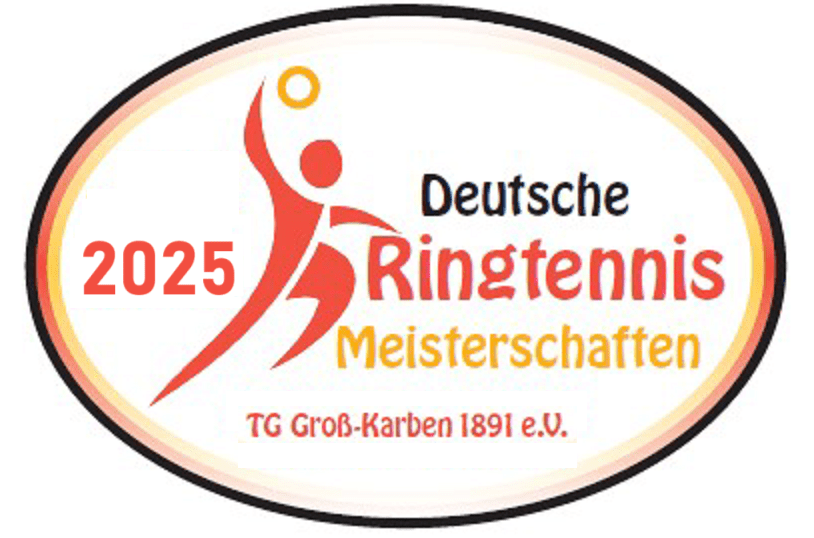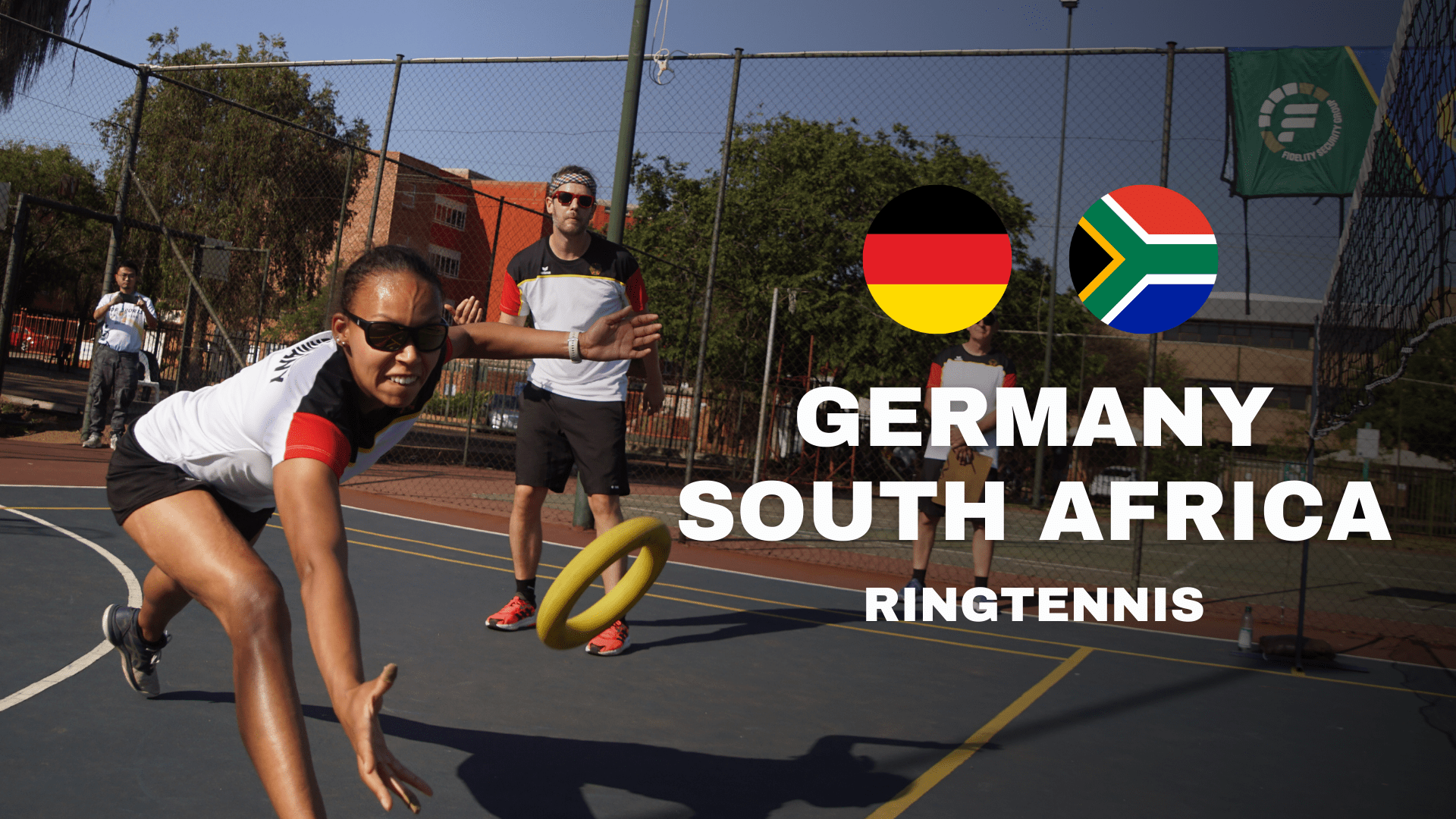The Official German Rules for the Game of Ringtennis
Contents
- Aim of the Game
- Court and Equipment
- The Court
- Duration of Play
- Injuries
- The Principles of Play
- The Serve
- Scoring
- Faults and Terminology
- Undisciplined Behaviour
- Umpires
1. Aim of the Game
The aim of the game of ringtennis is to throw a ring across a net into the opponent’s side of the court in such a way that he is unable to catch and return it.
2. Court and Equipment
2.1 For singles matches the court is 12.20 m long and 3.70 m wide. It is divided in the centre into two sides by a neutral zone 1.80 m in width.
2.2 For doubles matches the court is 12.20 m long and 5.50 m wide. The dimensions of the neutral zone are the same as for singles matches.
2.3 There is no limit as to how far the neutral zone extends out to the sides of the court.
2.4 The longer sides are called the sidelines and the shorter sides are called the baselines. All of the lines on the court must be clearly marked out and have a thickness of between 2 cm and 6 cm. The lines count as part of the court.
2.5 A net is hung over the middle of the court supported by two vertical posts. The net is 6.00 m long which means that it extends 25 cm over the sidelines. The net is 1.50 m high and must be taut.
2.6 As a safety precaution an area measuring 3.00 m from the outer edge of the court should be kept clear (according to the basic rules of the German Gymnastics Association’s regulations, appendix 3). If local conditions render this impossible, this rule may be waived.
The Court

2.7 The game is played with a rubber ring sanctioned by the DTB (The German Gymnastics Association). The ring weighs between 210 g and 230 g. The diameter of the rubber is approx. 2.9 cm and the inside diameter of the ring approx. 11.0 cm. The ring bears the imprint „Turnier-Ring DTB“.
2.8 The provisions of the rules defined below apply to both male and female players.
3. Duration of Play
3.1 The game is played with a time limit. Men’s singles, men’s doubles and mixed doubles matches played by participants aged between 19 and 29 are played for 10 minutes in both directions. All other matches are played for 8 minutes in both directions. Youth matches (M/F 14) are played for 6 minutes in both directions. The timekeeping is the responsibility of the tournament organisers.
3.2 In the event of a draw or a play-off paragraph 11.6.2 of the German Gymnastics Association’s‘ regulations [Ordnung des Fachbereiches Spiele (OFS)] applies.
3.3 Time lost due to interruptions must be made up in the same half. The umpire is responsible for the keeping of extra time.
3.4 Injuries
3.4.1 An injury does not count as an interruption. In the event of an injury the umpire asks the player to continue play. If this is not possible, the match is to be discontinued. The injured player is then no longer entitled to play in any other matches in this competition category. In the case of team tournaments paragraph 11.4.4.4 of the German Gymnastics Association’s regulations [Ordnung des Fachbereiches Spiele (OFS)] applies.
3.4.2 If a player starts to bleed during a match the umpire has to interrupt play so that the bleeding can be treated and stopped. The time lost due to the interruption is to be dealt with in accordance with paragraph 3.3. Before play starts again the ring has to be either cleaned or replaced.
4. The Principles of Play
4.1 Ring tennis players should wear suitable and appropriate dress.
4.2 Team players should compete in the same club dress (club strip with the club crest or emblem). Long tracksuit trousers or tights can be worn as club dress, when worn in mixed or doubles matches the players must, however, be wearing the same.
4.3 Choice of side is decided by the toss of a coin. The player who loses the toss has first serve and choice of ring. The players change sides at half-time and it is then the other player’s turn to serve and choose the ring.
4.4 If at the start of play of a doubles or mixed match, only one player turns up paragraph 4.1.3.4 ff of the German Gymnastics Association’s regulations [Ordnung des Fachbereiches Spiele (OFS)] applies.
4.5 A coach is allowed to stand at the back of the court during play. He must stand at least one meter behind the baseline.
4.6 Before play starts the coach must make sure that the umpire has noted his name down in the umpire’s book.
4.7 During play the coach is only allowed to tell his players how much time they still have to play. He is not allowed to use optical or acoustic signs to interfere with the course of play or to anticipate a decision of the umpire.
5. The Serve
5.1 The ring has to be served by the player, or in the case of doubles or mixed matches by one of the players, who won the last point.
5.2 The serve has to be made immediately and from behind the baseline. Both feet must be positioned behind the baseline.
5.3 In doubles and mixed matches the two players can take turns in serving as they like.
5.4 Before every serve the umpire starts play anew . He can do this with eye- contact, a hand signal or by requesting the player to „serve please“. If the serve is made without the umpire having given the order to recommence play, he can have the serve replayed.
6. Scoring
6.1 Each fault is an advantage to the opponent who then scores a „ring“.
6.2 The player (or players in the case of doubles and mixed matches) who scores the most „rings“ during the duration of the game wins the match.
6.3 If both teams score the same number of „rings“ the match is a draw.
6.4 If play has to be stopped (due to injury or a player being sent off) then the match ends with a score of 0:20 „rings“.
7. Faults and Terminology
7.1 Catch Faults
A player makes a catch fault:
7.1.1 when the ring touches the ground on his side of the court (technical term „ground“);
7.1.2 when a ring that has been caught is touching the ground somewhere (technical term „ground“);
7.1.3 when he was the last player to be in contact with a ring which falls to the ground either in the neutral zone or outside the bounderies of the court (technical term „touched“);
7.1.4 when he catches the ring with two hands, either with both hands at the same time or one after the other (technical term „double catch“);
The „hand“ refers to the area between the finger tips and the elbow. You are allowed to recatch the ring using the same hand with the help of any part of the body.
In doubles or mixed matches both players can be involved in the catch. A „double catch“ only occurs when one of the two players touches the ring with both hands.
7.2 Faulty Shots
A player makes a faulty shot
7.2.1 when he throws the ring outside the boundaries of his opponent’s side of the court (technical term „outside“);
7.2.2 when the ring or he himself touches the net or the post (technical term „net“);
7.2.3 when the player’s hand is not used to throw the ring over the net (technical term „faulty shot“);
7.2.4 if, after he has thrown the ring, it fails to continue along its path through the air and starts looping or wobbles considerably – more than the width of the ring – (technical term „wobble“);
7.2.5 when he throws the ring from above, i.e. the ring is pulled, thrust or slung downwards (techical term „downward shot“);
7.2.6 when, during any part of the execution of the throw or the throwing motion itself, the movement doesn’t flow (is interrupted) (technical term „delayed shot“);
The catch is concluded when the hand closes round the ring.
The return throw must be executed immediately after the catch. Compared with the body, the ring should always be on the move.
Interruptions (delays) which result from:
- running for a ring,
- a player falling when attempting to catch the ring,
- one of the players being injured slightly,
- a ring being recaught,
- a ring being caught with the help of a part of the body,
- both players in a doubles or mixed match catching (touching) the ring at the same time or immediately after one another.
are allowed.
After such an interruption the player who caused it must play the ring high up into the back third of his opponent’s side of the court. If play is interrupted by the umpire (technical term „stop“) the ring has to be played up high twice into the back third of the opponent’s side of the court. The player who has been disadvantaged starts.
7.2.7 if the ring hasn’t been played up high into the back third of the opponent’s side of the court after an interruption or been played up high twice into the back third of the opponent’s side of the court after play has been interrupted by the umpire (technical term „faulty high play“); after the kind of difficult catch situation specified in 7.2.6 the ring only has to be played up high once, even if in this situation there is some kind of additional external disruption i.e. a ring from another court.
7.2.8 if he changes the direction of his shot or the type of shot during the throwing motion (technical term „two-way movement“);
7.2.9 if, in the case of matches played indoors, the ring touches the ceiling (technical term „ceiling“);
7.3 Other Faults
A player makes a fault
7.3.1 when, after having caught the ring, he runs, dribbles or walks with the ring towards the net (technical term „three steps“); the player is allowed to take two steps once the ring has been caught. The ring has to be played again before he takes his third step. Each foot that touches the ground counts.
7.3.2 when he fails to serve from behind the baseline of the court or when he steps over the baseline into the court while serving. (technical term „pass over“);
7.3.3 when he steps into the neutral zone itself or into the area at the side into which the neutral zone extends (technical term „pass over“);
8. Undisciplined Behaviour
A player behaves in an undisciplined way when, on account of his behaviour, it is no longer possible to carry out the match in an orderly fashion. Such misconduct is penalized (technical term „undisciplined behaviour“).
Undisciplined behaviour is considered to be:
- addressing the umpire in a disrespectful manner
- criticising the umpire’s decisions
- any form of attack on the umpire or an opponent
- deliberate delaying tactics
- disruptive interference from a coach (in which case the coach is warned or the player is penalized with a fault)
When a player has been faulted three times on account of undisciplined behaviour he is asked to leave the court. In the case of a serious violation the player can be told to leave the court immediately. Should further punishment be necessary this is dealt with in paragraph 5.1.2 of the German Gymnastics Association’s Regulations [Ordnung des Fachbereiches Spiele (OFS)].
9. Umpires
In addition to appendix 2 of the German Gymnastics Association’s Regulations [Ordnung des Fachbereiches Spiele (OFS)], the regulations for umpires of the DTB (the German Gymnastics Association) point 1 and 2, the following also applies: all matches are to be umpired by one umpire who can be aided by two linesmen. The linesmen are to position themselves at the edge of the court, level with the baseline, and only announce their decision when asked to do so by the umpire. The umpire should be positioned next to one of the net posts. He starts and stops play and has the right to interrupt the match (i.e. in the case of external disruptions, a ring from another court being thrown into the court, the lines of the court or the construction of the net needing attention, a ring touching equipment in the hall).
Ordnung des Fachbereiches Spiele
The German Gymnastics Association’s Regulations [Ordnung des Fachbereiches Spiele (OFS)] are unfortunately not available on the internet. You can order it from the DTB. Information about the German Gymnastics Association’s Regulations is also available from the information team.


